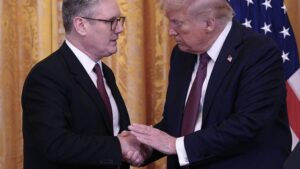THE NEWS: What Happened
The United Kingdom and United States have formalized a £31bn technology partnership that represents one of the most significant bilateral innovation agreements in decades, combining government strategy with corporate investment to create competitive advantages in artificial intelligence, quantum computing, and advanced manufacturing. The deal, announced during President Trump’s state visit, includes Microsoft’s record £22bn UK commitment for AI infrastructure development, Google’s £5bn investment in research and data centers, Salesforce’s £1.4bn operational expansion, and OpenAI’s establishment of UK operations as part of its international Stargate project.
The agreement extends beyond corporate investment to include systematic support for British startups through dedicated “AI growth zones” in northeast England, promising 5,000 jobs and billions in private investment attraction. Nvidia will deploy 120,000 advanced processors across UK installations while providing training programmes specifically designed for small technology companies, creating direct pathways between startup innovation and global market access through established technology platforms.
The partnership reflects strategic alignment between UK research capabilities and American capital deployment, positioning both countries to compete more effectively against Chinese technology advancement and European Union industrial policy initiatives. Beyond headline investment figures, the deal includes specific mechanisms for startup development, research collaboration, and infrastructure sharing that suggest systematic rather than symbolic cooperation between the world’s two largest English-speaking technology ecosystems.
THE INTELLIGENCE: What It Means
This agreement signals recognition that technology leadership in the next decade will depend on coordinated national strategies rather than purely market-driven outcomes, with democratic allies choosing collaboration over competition to maintain advantages against state-directed technology development in non-democratic systems. The scale and structure of the partnership—combining government policy with corporate investment totaling £31bn—indicates both countries view technology cooperation as essential for economic and strategic security rather than optional commercial enhancement.
The timing reflects growing urgency about maintaining Western technology leadership as Chinese artificial intelligence capabilities advance and European Union industrial policies create competitive pressures through coordinated investment and regulatory frameworks. By combining British research excellence with American venture capital and corporate resources, both governments are betting that democratic cooperation can compete effectively against centralized technology planning while preserving innovation advantages that emerge from competitive markets.
The geographic distribution deserves particular attention, with northeast England designated as the primary beneficiary region rather than traditional technology centers like London or Cambridge. This suggests deliberate policy to create competitive alternatives to established technology clusters while addressing regional economic development priorities that could determine political sustainability for technology investment policies across electoral cycles.
The corporate commitment structure reveals sophisticated coordination between government policy and private sector investment that extends beyond typical trade promotion or foreign investment attraction. Microsoft’s £22bn commitment represents the company’s largest single-country investment outside the United States, while Google and Salesforce commitments indicate systematic rather than opportunistic corporate positioning in anticipation of sustained government support and favorable regulatory treatment.
The startup-specific provisions—AI growth zones, dedicated training programmes, and direct corporate partnership opportunities—suggest recognition that technology leadership requires comprehensive ecosystem development rather than only supporting established companies or fundamental research. This approach may prove more effective than previous technology policies focused on research and development funding without systematic commercialization and scaling support.
The international implications extend beyond bilateral cooperation toward potential template development for broader democratic technology alliances. Similar agreements between other democratic technology powers could create systematic advantages in research, development, and market access that compete effectively with state-directed technology strategies while maintaining competitive market structures that drive continued innovation.
THE BRIDGE: What To Do About It
For venture capitalists evaluating opportunities created by systematic government-corporate technology cooperation, this UK-US partnership highlights investment themes around infrastructure development, cross-border collaboration, and policy-supported sector development that extend far beyond individual company opportunities toward systematic ecosystem advantages. The most compelling applications appear to be companies that can leverage coordinated infrastructure investment and international partnership frameworks to achieve scale and market access advantages over purely domestic competitors.
Similar opportunities requiring strategic evaluation:
- Cross-border AI infrastructure development: Companies building technology platforms that leverage coordinated government investment in computing infrastructure, data sharing, and research collaboration across democratic allies
- Quantum computing commercialization platforms: Startups developing practical applications for quantum technology advances supported by coordinated research investment and infrastructure development between allied countries
- Defense and dual-use technology: Companies creating civilian applications for military research cooperation, particularly those addressing cybersecurity, communications, and advanced manufacturing challenges common to democratic allies
Active strategic frameworks for investment opportunity:
- Government-backed venture investment: Sovereign wealth funds and strategic investment vehicles from democratic countries seeking technology cooperation opportunities and cross-border market access
- Corporate strategic partnerships: Major technology companies implementing systematic international expansion strategies through government partnership frameworks rather than purely commercial relationships
- Defense and intelligence investment: Strategic capital targeting dual-use technologies that serve both commercial markets and national security requirements across allied democratic countries
- Infrastructure development finance: Development banks and strategic investment funds targeting technology infrastructure projects that create systematic competitive advantages for democratic technology ecosystems
For founders targeting opportunities created by international technology cooperation, this UK-US partnership provides strategic guidance about positioning companies to benefit from systematic government support while maintaining commercial viability across multiple markets. Rather than depending purely on government contracts or subsidies, successful companies will likely need to demonstrate clear commercial applications while addressing strategic technology requirements that justify continued policy support across electoral cycles.
Market timing appears critical for companies seeking to benefit from coordinated international technology investment, as policy priorities and funding availability may shift based on geopolitical developments and domestic political changes. Companies that can demonstrate early traction and clear strategic value may achieve sustainable competitive advantages through infrastructure access and partnership opportunities that prove difficult for competitors to replicate.
International expansion strategies should consider the template potential of bilateral technology partnerships, as similar agreements between other democratic allies could create broader market opportunities for companies that successfully navigate initial UK-US collaboration frameworks. Early success in government-supported international partnerships may provide advantages in subsequent market opportunities as technology cooperation expands across additional countries.
Technology selection should prioritize areas where democratic cooperation provides clear advantages over alternative approaches, particularly those requiring systematic infrastructure investment, coordinated regulatory frameworks, or extensive research collaboration that democratic governments can provide more effectively than authoritarian alternatives or purely commercial relationships.
For established technology companies evaluating strategic responses to systematic government cooperation initiatives, the UK-US partnership suggests that international expansion strategies may need to incorporate government relationship development alongside traditional market entry approaches. Companies that can effectively combine commercial objectives with strategic technology cooperation may achieve sustainable competitive advantages while supporting broader democratic technology leadership objectives.
Corporate development opportunities exist for companies seeking to expand international operations through government-supported partnership frameworks rather than purely commercial expansion strategies. The systematic nature of UK-US technology cooperation may provide acquisition and partnership opportunities that combine market access with strategic positioning advantages across multiple countries implementing similar technology cooperation policies.
Regional development implications suggest that technology companies may find strategic advantages in locating operations in designated cooperation zones rather than traditional technology centers, particularly if government support includes infrastructure access, regulatory advantages, and coordinated international market development that justify alternative location decisions.








